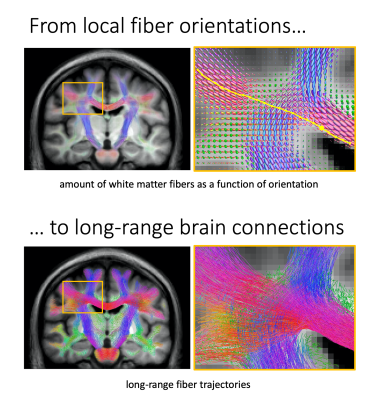Tracking Off the Beaten Track
Ben Jeurissen1
1imec-Vision Lab, Dept. of Physics, University of Antwerp, Belgium
1imec-Vision Lab, Dept. of Physics, University of Antwerp, Belgium
Synopsis
Fiber tracking is the only tool that can delineate specific fiber bundles within the brain in-vivo, enabling region-specific investigation of MRI parameters and helping neurosurgeons to plan delicate neurosurgery. Fiber tracking has also claimed a central role in the field of ‘connectomics’, the study of the complex network of connections within the brain. Despite these unique abilities and exciting applications, fiber tracking is not without controversy, in particular when it comes to its interpretation. In light of this controversy, this course will provide an overview of the concepts, technical considerations, algorithms, mistakes and challenges of fiber tracking.
Introduction
In the last decades, fiber tracking (see Figure) has become the method-of-choice to investigate MRI parameters in specific bundles of white matter during development, aging and training and for a wide range of diseases. For the neurosurgeons, fiber tracking is quickly becoming an invaluable tool for surgery planning, allowing for visualization and localization of the vital white matter pathways before and even during surgery. Fiber tracking has also claimed a central role in ‘connectomics’, the study of the complex network of connections within the brain. Despite its unique abilities and exciting applications, fiber tracking is not without controversy, in particular when it comes to its quantification and interpretation. In light of this controversy, this course will provide an overview of the key concepts of tractography, the technical considerations at play, the different types of algorithms, and the common misconceptions and mistakes that surround them. We will also highlight the ongoing challenges related to fiber tracking.Key concepts and terminology
Fiber tracking and its most fundamental terminology will be reviewed, including:- fibers, fiber tracts, and the connectome
- streamline tractography, tracks, and tractogram
- the virtual nature of fiber tracking
Technical considerations
The main technical considerations when designing a fiber tracking algorithm will be reviewed, including:- local fiber orientation estimation
- integration
- interpolation
- seed point selection
- track termination and acceptance criteria
- anatomical constraints
- virtual dissection
Fiber tracking algorithms
A brief overview of families of tracking algorithms will be given based on their most distinguishing features, including:- deterministic vs probabilistic
approaches
- local vs global approaches
- track filtering approaches
Common misconceptions and mistakes
There are a lot of misconceptions that surround fiber tracking and not recognizing its many technological pitfalls can easily lead to over-interpretation of the results. In this segment, the participant will learn:- fiber tracking is more than just following the path of least diffusion hindrance
- different flavors of probabilistic fiber tracking exist, each with a very distinct interpretation
- integration errors and error propagation can have unexpected consequences
- quantification of fiber tracking results is a slippery slope: track densities (intra-voxel) and connection strengths (inter-voxel) debunked
Ongoing challenges and continuing headaches
In this segment, the participant will learn about:- The ill-posed nature of fiber tracking
- The difficulties of tracking near the cortex
- The spatial and angular resolution limits
- The issue of false positives
Conclusion
After this lecture, the audience should understand that fiber tracking is a complicated endeavor involving many steps (local fiber orientation modeling, interpolation, integration/propagation, seeding, masking, stopping criteria, etc.), each incurring potential errors. It should also be clear that fiber tracks are virtual entities that encompass no physical volume and that are related only indirectly to the nerve fibers. The audience should be able to explain the difference between deterministic and probabilistic approaches, and between local and global approaches. Participants should understand that, regardless of the algorithm, fiber tracking is an ill-posed problem and that there are limits when it comes to its quantification and biological interpretation.Acknowledgements
BJ is supported by the Research Foundation Flanders (FWO Vlaanderen).References
Jeurissen B, Descoteaux M, Mori S, Leemans A. Diffusion MRI fiber tractography of the brain. NMR Biomed. 2019;32: e3785.Figures

Fiber tracking in a nutshell: By measuring the dMRI signal for each imaging voxel along a number of non-collinear orientations, the local fiber orientations can be assessed throughout the tissue-of-interest (top). These local fiber orientations can then be pieced together to infer long-range pathways connecting distant regions of the brain, a process that is most often called fiber tracking or fiber tractography (bottom).